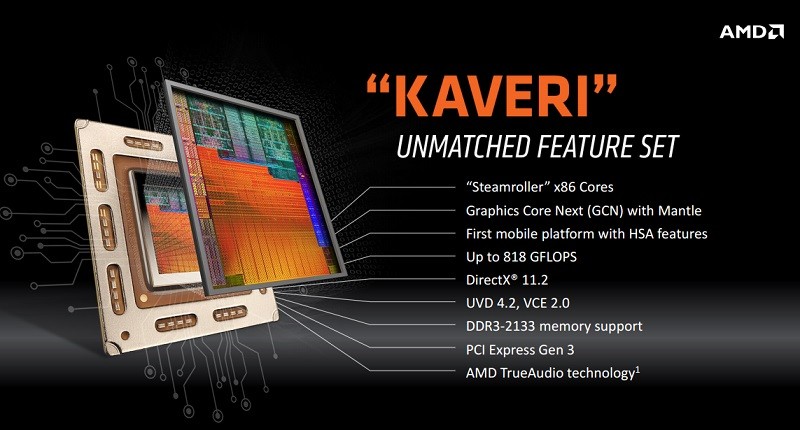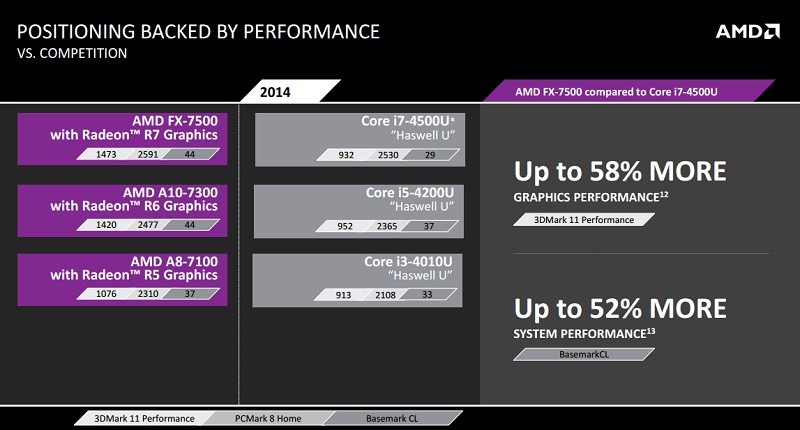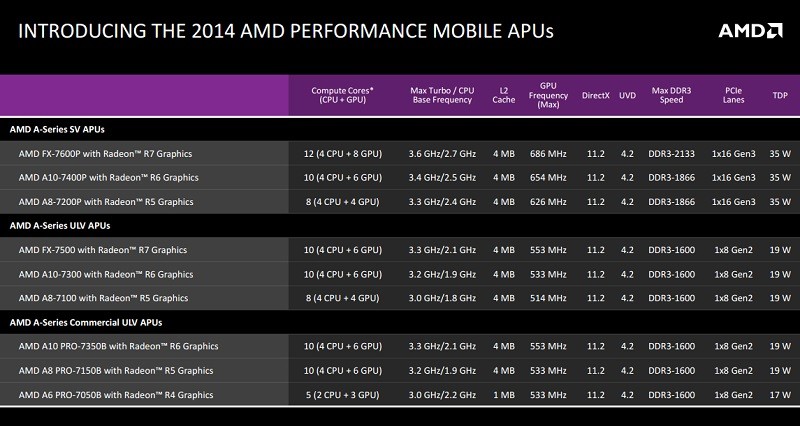Back in January, AMD launched their desktop Kaveri APUs which promised to be the most powerful the company had ever made, especially in the graphics department. A few months later and AMD was ready to launch Beema and Mullins, designed specifically for low-power tablets and notebooks, already producing impressive performance when I went hands-on a few months ago.
Announced at Computex 2014, AMD is ready to complete their processor product stack with performance-oriented Kaveri mobile APUs. The company claims these chips have an "unmatched" feature set, including the same x86 Steamroller cores found in desktop Kaveri variants, a GCN GPU that supports Mantle and TrueAudio, DDR3-2133 memory support, and HSA.

AMD has nine Kaveri mobile chips on offer: three from their A-Series SV line, three ULP parts, and another three "Pro" SKUs designed specifically for commercial applications. The company is also using FX branding for their top-of-the-line parts, making it the first time AMD has released FX-branded mobile chips.
AMD once again aren't afraid to compare their chips with Intel's, claiming the new FX-7500 - a quad-core SKU clocked at a maximum frequency of 3.3 GHz and packing six GPU cores - is over 50% faster in compute and graphics tasks than Intel's Haswell-based Core i7-4500U. Interestingly AMD lists a higher TDP for their APU than Intel (19W vs 15W), so performance gains may be at the expense of energy efficiency.

The company also boasts wins with their other APUs, including the new Pro line that features "superior performance with commercial stability and manageability". Specifications and performance for the two higher-end Pro SKUs appear identical to the standard ULP Kaveri parts, but we'll likely see them crop up in different systems with a different set of power optimizations.
At the briefing, not much was talked about the most powerful Kaveri mobile APUs, such as the 35W FX-7600P, however they will be seen mostly in gaming and performance notebooks, which only occupy a small segment of the market. The FX-7600P so happens to be AMD's highest-end Kaveri mobile SKU, packing four CPU cores and eight GPU cores, clocked up to 3.6 GHz and 686 MHz respectively. It also supports DDR3-2133 memory and 16 PCIe 3.0 lanes.

I had a short hands-on time with an AMD reference Kaveri notebook powered by the top-of-the-line FX-7600P APU, complemented by 8 GB of RAM and a 1080p display. The notebook was able to play Battelfield 4 on medium settings at 1080p, with Mantle enabled, at a reasonable frame rate, which isn't too bad for a laptop without discrete graphics.
The laptop also didn't seem to struggle manipulating high-resolution images in Photoshop, which can occasionally be tough for laptops without the power of a desktop. That said, the APU inside the system is a 35W part, so you woud expect it could handle these sorts of tasks.
Of course having great APUs means nothing if there's no hardware wins to show them off, and that's one of the things I eagerly await hearing from AMD's hardware partners. While the company may be struggling to get Mullins into devices instead of Intel's Bay Trail, they've had more success in the notebook space, so I'm hoping we'll soon start to see mobile Kaveri and Beema pop up in the market.
https://www.techspot.com/news/56950-amd-launches-mobile-kaveri-apus-at-computex.html
